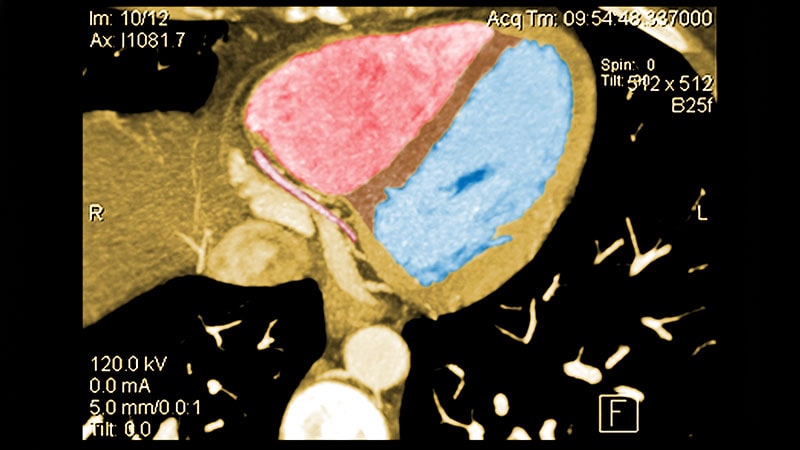Subclinical Coronary Atherosclerosis Predicts Myocardial Infarction Risk
핵심 개념
Subclinical coronary atherosclerosis, even when non-obstructive, significantly increases the risk of myocardial infarction in asymptomatic individuals.
초록
Introduction
- Middle-aged adults without CV symptoms have coronary atherosclerosis.
- Study suggests substantial MI risk in this population.
Risk Assessment
- Participants with obstructive subclinical disease had a ninefold increased MI risk.
- Obstructive disease elevates risk more than non-obstructive but extensive disease.
- Findings consistent with other CV risk assessment methods.
Implications
- CTA imaging not commonly used for atherosclerosis screening.
- Potential for opportunistic screening for subclinical coronary disease.
- Identification of atherosclerosis could lead to intensified primary prevention therapy.
Screening Role
- Uncertainty about CTA's role in asymptomatic adults.
- Study highlights the importance of plaque burden in predicting coronary events.
- Unique insights from the Danish cohort analysis.
Graded Risk
- Analysis included 9533 asymptomatic individuals aged 40 and older.
- Extensive and obstructive disease significantly increased MI risk.
- Composite risk of death or MI also elevated in extensive disease cases.
Ongoing Trials
- Randomized trials exploring outcomes related to plaque burden.
- DANE-HEART and SCOT-HEART 2 trials investigating CTA for primary prevention.
요약 맞춤 설정
AI로 다시 쓰기
인용 생성
소스 번역
다른 언어로
마인드맵 생성
소스 콘텐츠 기반
소스 방문
www.medscape.com
Subclinical CAD by CT, Stenoses or Not, Predicts MI Risk
통계
The adjusted relative risk (RR) for MI compared to those without coronary atherosclerosis was:
7.65 (95% CI, 3.53 - 16.57) overall in patients with extensive disease
8.28 (95% CI, 3.75 - 18.32) in those with obstructive but non-extensive disease
9.19 (95% CI, 4.49 - 18.82) overall in those with obstructive disease
12.48 (95% CI, 5.50 - 28.12) in those with obstructive and extensive disease
The adjusted RR for the composite of death or MI was also elevated in persons with extensive disease:
2.70 (95% CI, 1.72 - 4.25) in those with extensive but nonobstructive disease
3.15 (95% CI, 2.05 - 4.83) in those with extensive and obstructive disease
인용구
"Identification of luminal obstructive or extensive subclinical coronary atherosclerosis" - Study report
"The more plaque individuals have, the higher the risk." - Ron Blankstein, MD

더 깊은 질문
What are the potential implications of using CTA for opportunistic screening in asymptomatic individuals?
The potential implications of using CTA for opportunistic screening in asymptomatic individuals are significant. By identifying subclinical coronary atherosclerosis in individuals without symptoms, healthcare providers can assess their risk for myocardial infarction (MI) and provide early intervention strategies. This proactive approach allows for the early detection of obstructive or extensive disease, which can lead to the initiation of intensified cardiovascular primary prevention therapy. Additionally, opportunistic screening with CTA can offer incremental risk assessment in nonischemic patients undergoing cardiac CT or electrocardiogram-gated chest CT for other reasons, such as arrhythmia ablation or valve repair. This can help in identifying individuals who may benefit from early intervention and preventive measures to reduce their risk of cardiovascular events.
How might the findings of this study impact current practices in cardiovascular risk assessment?
The findings of this study can have a significant impact on current practices in cardiovascular risk assessment. The study demonstrates that subclinical coronary disease, whether obstructive or extensive, is associated with a higher risk of MI in asymptomatic individuals. This highlights the importance of assessing coronary atherosclerosis in individuals without symptoms to identify those at increased risk of cardiovascular events. Healthcare providers may consider incorporating CTA as a screening tool for subclinical coronary disease in asymptomatic individuals, especially those undergoing imaging for other purposes. The identification of obstructive or extensive disease can lead to the implementation of more aggressive primary prevention strategies, potentially reducing the risk of future cardiovascular events in this population.
How can the insights from the Danish cohort analysis be applied to other populations globally?
The insights from the Danish cohort analysis can be applied to other populations globally to improve cardiovascular risk assessment and primary prevention strategies. The study's findings on the association between subclinical coronary disease and the risk of MI provide valuable information that can be extrapolated to different demographic groups and geographic regions. Healthcare providers worldwide can consider incorporating CTA or similar imaging modalities for opportunistic screening of coronary atherosclerosis in asymptomatic individuals to identify those at higher risk of cardiovascular events. By recognizing the predictive value of obstructive or extensive disease in assessing MI risk, clinicians can tailor preventive interventions to individuals with subclinical coronary disease, regardless of their symptoms. This approach may help in reducing the burden of cardiovascular disease on a global scale by targeting high-risk individuals for early intervention and preventive measures.
0
